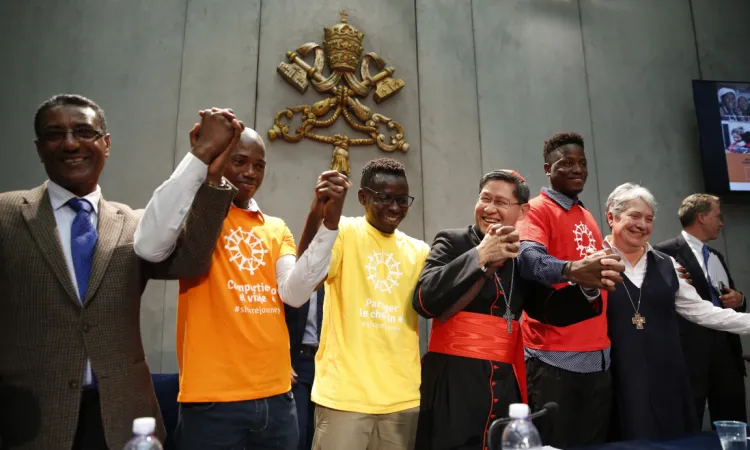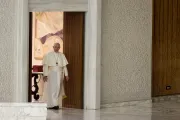Cardinal Leonardo Sandri, the prefect of the Congregation for Eastern Churches, is 76. According to rumors, the next prefect will be Archbishop Pierbattista Pizzaballa, apostolic administrator of the Latin Patriarchate of Jerusalem. Archbishop Pizzaballa gained much credit when Pope Francis asked him to organize the prayer for peace in the Vatican Garden in 2014.
Other rumors say that the Pope could also look to the US and choose as new prefect the eparch of the Maronite Eparchy of St. Maron of Brooklyn, Gregory John Mansour, who was recently appointed chairman of Catholic Relief Services.
There will also be a new prefect at the Congregation for Catholic Education. The current prefect is Cardinal Giuseppe Versaldi: he turned 76, one year more than the retirement age set at 75. After the reform, the Congregation will absorb the Pontifical Council for Culture. Cardinal Gianfranco Ravasi, president of the Pontifical Council, is 79, and Pope Francis prorogated his mandate at the helm of the dicastery until he will be 80.
It is hard to foresee who will be the new prefect of the Congregation. There might also be a new secretary, since Archbishop Vincenzo Zani could be moved to the position of Chancellor of the Pontifical Academy for Sciences to replace Archbishop Marcelo Sanchez Sorondo, now 77.
More in A Vatican Observer
Cardinal Beniamino Stella, Prefect of the Congregation for the Clergy, turned 78, and is now three years beyond the retirement age. He is considered one of Pope Francis' most trusted men, and for this reason, Pope Francis will have a hard time replacing him. His successor will also give clues about how Pope Francis is going to govern in this phase. Among the possible candidates for the succession is Cardinal Blaise Cupich, archbishop of Chicago.
There might be changes also in the Congregation of Bishops. Cardinal Marc Ouellet, the prefect, recently turned 75. A deep connoisseur of Latin America, Cardinal Ouellet is also considered a papabile. His position at the helm of the Congregation might be prorogated.
However, the secretary of the Congregation might change. Monsignor Fabian Pedacchio Leaniz left the position of Pope Francis' secretary and is now in full time at the Congregation for Bishops, where he has been working part-time since the election of Pope Francis. He might be appointed secretary and elevated to the rank of archbishop.
The current secretary, archbishop Ilson Montanari de Jesus, might be appointed archbishop of San Salvador de Bahia, primatial diocese of Brazil. The current archbishop of Salvador de Bahia is Murilo Sebastiao Ramos Krieger, who turned 76. As archbishop of Salvador de Bahia, Montanari could also get the red hat.
The Curia is not Pope Francis' only field of action. Francis has been working to change the profile of bishops. In particular, he focused his attention on two specific Churches considered among the most conservative: the US Church and the Italian Church.
Regarding the United States, the possible candidature of the Jesuit Fr. James Martin as Archbishop of Philadelphia created turmoil. Father Martin is known for his dialoguing position with the LGBT community; his statements have been often labeled as controversial.
Observers say that this is just a rumor, and that Fr. Martin's appointment as archbishop of Philadelphia is unlikely. However, if Fr. Martin made it to Philadelphia, this would be a considerable shift for one of the most senior archdioceses of the US. Philadelphia has been until now under the guidance of Archbishop Charles J. Chaput, who just turned 75. Archbishop Chaput is strong on doctrine and cultural issues and has been a real mentor for generations of American Catholics.
(Column continues below)
Subscribe to our daily newsletter
Regarding Italy, two archdioceses will experience major overhauls: Genoa and Naples.
Genoa is now led by Cardinal Angelo Bagnasco, who is also president of the Council of the European Bishops Conferences, and served until 2017 as president of the Italian Bishops Conference. Cardinal Bagnasco turned 75 in 2017. Pope Francis prolonged his mandate by two years. In January, he will turn 77, and Pope Francis will select his successor. One of the primary candidates for the post seems to be Fr. Giacomo Costa, Jesuit, currently director of the magazine Aggiornamenti Sociali. Fr. Costa was very much appreciated in the Vatican as special secretary of the 2018 Synod on Youth and as secretary of the Commission for the Information of the 2019 Panamazonian Synod.
A Jesuit could administer even the Archdiocese of Naples. Cardinal Crescenzio Sepe will turn 77 next year.His ecclesiastical career developed under John Paul II pontificate before his appointment as Archbishop of Naples under Benedict XVI. Now, it is retirement time for him and time for a shift for the archdiocese. Water cooler talk hasFr. Antonio Spadaro SJ, editor of La Civiltà Cattolica, in the running for the spot. Spadaro is considered one of Pope Francis' most trusted advisors.
Fr. Spadaro might carry forward from within the Italian bishops conference his project of a "Synod of the Italian Church" . This project was sponsored by the Vatican newspaper L'Osservatore Romano but actually did not get much traction among the Italian bishops. Pope Francis backs the plan, while Cardinal Gualtiero Bassetti, currently president of the Italian Bishops Conference, does not. However, Cardinal Bassetti is already 77. He might end his mandate as president of the Italian bishops and also retire as archbishop of Perugia – Città della Pieve.
In this case, the race would be open for a new president of the Italian Bishops Conference. One of the strongest candidates might be Cardinal Matteo Zuppi, archbishop of Bologna. Pope Francis likes him a lot. Coming from the Sant'Egidio movement, Cardinal Zuppi's profile goes, in fact, beyond the movement he belongs to. For this reason, he might be a strong candidate in a conclave, along with Cardinal Tagle.
If everything goes according to rumor, one can conclude that Pope Francis decided to look within the Jesuits to face a moment of crisis and prepare the future. Pope Francis also appointed the Fr. Juan Antonio Guerrero Alves SJ as prefect of the Secretariat for the Economy. Fr. Guerrero will not be ordained bishop and will go back to the Jesuits at the end of his mandate.



